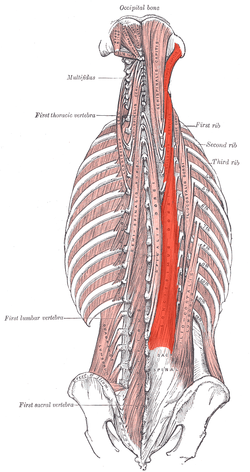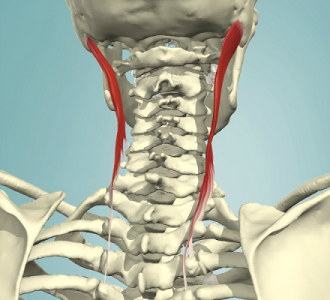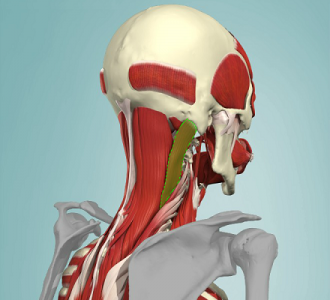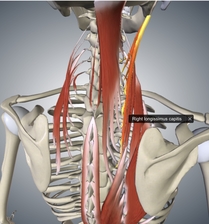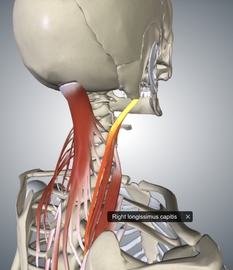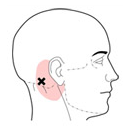Longissimus Capitis
Original Editor Oyemi Sillo
Top Contributors - Evan Thomas, Lucinda hampton, Merihan Hussein, Kim Jackson, Oyemi Sillo, WikiSysop, 127.0.0.1 and Frank Edmund IheakamIntroduction[edit | edit source]
The longissimus muscle is not one muscle, but a collection of three separate muscles that run up nearly the entire length of both sides of the spinal column, from the lower back up to the neck. These three muscles include:
- Longissimus capitis
- Longissimus cervicis
- Longissimus thoracis[1]
Longissimus belongs to the intermediate column of the erector spinae group of muscles.[2]
Longissimus Capitis[edit | edit source]
Longissimus Capitis depicted below.
Origin[edit | edit source]
Posterior surface of transverse processes of T1 to T5 and the articular tubercle of C4 to C7.[3]
Insertion[edit | edit source]
Posterior margin of mastoid process and the temporal bone.[3][4]
Nerve Supply[edit | edit source]
Dorsal rami of cervical and thoracic spinal nerves (C6 to T4).[5]
Blood Supply[edit | edit source]
Muscular branches of the occipital artery from the external carotid artery.[5]
Action[edit | edit source]
Acting bilaterally, extends and hyperextends head; acting unilaterally, flexes and rotates the head ipsilaterally.[3]
Trigger Point Referral Pattern[edit | edit source]
Pain is usually referred around the ear, but can also refer nearby into the neck and behind the eye.[6]
Muscle Activation[edit | edit source]
The 5 minutes video below is titled Deep Cervical Flexor Isolated Activation (Longus Colli, Longus Capitis & Rectus Capitis).
In summary it describes a chin retraction exercise for neck pain that works on the local stabilising the deep neck flexors.
- The exercise starts in standing in front of mirror, to provide feedback to client re neck posture.
- Client has arms at 90 degrees flexions holding onto mirror with theraband resistance band looped behind upper neck.
- The action is then to retract chin backwards with a chin tuck, against the resistance band, checking all the while for good postural control.
- The hardest part of the exercise is the final part, getting chin back to neutral or beyond.
- Client performs 12-20 repeats with slow 2-4 counts, 1-3 sets.
References[edit | edit source]
- ↑ Study.com Longissimus Available:https://study.com/academy/lesson/longissimus-muscle-origin-insertion-function.html (accessed 5.2.2022)
- ↑ Gray, Henry. Anatomy of the Human Body. Philadelphia: Lea & Febiger, 1918; Bartleby.com, 2000. www.bartleby.com/107/.
- ↑ 3.0 3.1 3.2 http://www.wheelessonline.com/ortho/longissimus_capitis_1
- ↑ http://www.primalonlinelearning.com/cedaandp/muscular_system/muscles_of_the_back.aspx#longissimuscapitis
- ↑ 5.0 5.1 http://www.anatomyexpert.com/structure_detail/5205/
- ↑ http://abbottcenter.com/bostonpaintherapy/?p=1492
